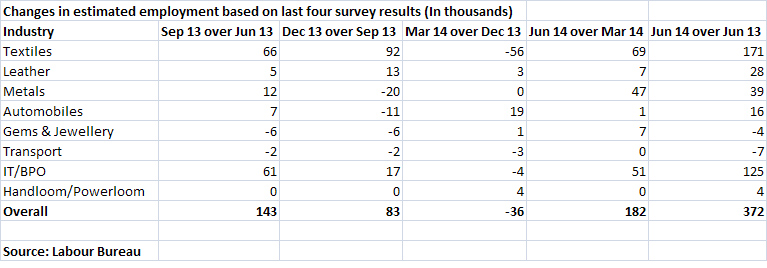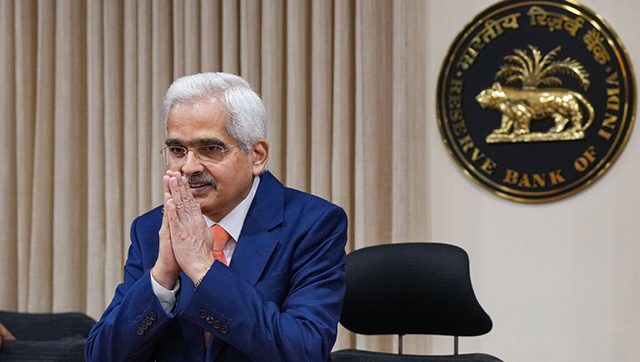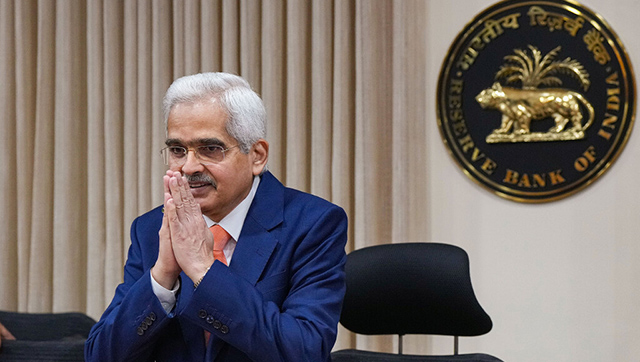First the good news: Indian companies created more jobs in April-June on a sequential basis. In fact, the jobs creation hit a 10-quarter high.
Next comes the bad news: there is nothing much to celebrate about it because the rise comes on a steep decline in the previous quarter.
But here is a worse news: wage growth is moderating, which is likely to impact consumer spending and, in turn, growth.
According to data available in the Labour Bureau, during April-June overall employment increased by 182,000 over the previous quarter. The highest jump happened in the textile sector, where 69,000 jobs were added. IT/BPOs witnessed an increase of 51,000, metal 47,000, and leather and gems & jewellery 7,000 each and the automobiles sector just 1,000, the data showed.
Of the overall increase, 156,000 were direct category jobs, and the balance 26,000 contract category.
At the outset, the data paints a rosy picture of the jobs scene. But the proverbial devil is in the detail.
As Dhananjay Sinha and Nikhil Gupta of brokerage firm Emkay note in a recent research report, the rebound in employment generation in the first quarter of this financial year is likely to be a “compensatory fillip” for the contraction witnessed a quarter earlier.
“…It is important to note that employment contracted 36K in Q4 FY14, implying an average addition of 73K in the past two quarters, lower than quarterly average addition of 105K in the previous year (long-term average of +184K per quarter),” the analysts said in the note.
So, average employment gain in the first half of calendar year 2014 is lower than in the previous four quarters, the report said.
The brokerage attributes the reason for the contraction in jobs during the fourth quarter of last financial year to the political uncertainties related to the general elections.
“Uncertainty in the run up to the General Elections might have tempted companies to delay their hiring plans in Q4 FY14, while election results must have imbibed confidence, leading to compensatory hiring in Q1 FY15,” the note said.
Further, the data doesn’t support the widely held belief that with a stable government at the Centre and improving business sentiment, job market will get a huge fillip.
The research report notes that India’s job elasticity was 0.2x during 2000-10, when the country was also in a high growth phase.
The RBI defines employment elasticity as “a measure of the percentage change in employment associated with a 1 percentage point change in economic growth.” It indicates “the ability of an economy to generate employment opportunities for its population as per cent of its growth (development) process.”
So 0.2x reading means every one percent growth in GDP will increase the job opportunities by 20 basis points. One basis point is a hundredth of 1 percent.
In other words, during the period India grew by 7.2 percent on an average, job opportunities increased by 20 bps per percentage point. This year, wide expectation is that the GDP growth will at the most be 5.5 percent, which is terribly insufficient to create growth.
“At the same elasticity (of 0.2x), real GDP needs to grow at 7.5% to prevent employment rate from falling. At the current rate of real GDP growth of 4.5%-5.5%, enough employment opportunities are not being generated,” the research note says.
In short, the rise in employment witnessed in the first quarter is transitory.
What is more worrying is the fact that nominal wage growth moderated to 8.5 percent in the first quarter of the financial year. According to Emkay, this is the lowest in 18 quarters. The brokerage has analysed CMIE data on aggregated wages and salaries expenses of the seven industries for which employment data is provided by the Labor Department.
The moderation in wage growth has a direct correlation with private consumption and demand environment in the economy. Without an increase in wages, one cannot expect a rise in consumer spending, especially at a time when retail inflation remains at an elevated level.
The data point is significant as it reveals one of the weakest spots in the economy and also beats hollow the brouhaha in the stock markets. For Prime Minister Narendra Modi, who came to power promising jobs, there is a tall task ahead.


)




)
)
)
)
)
)
)
)